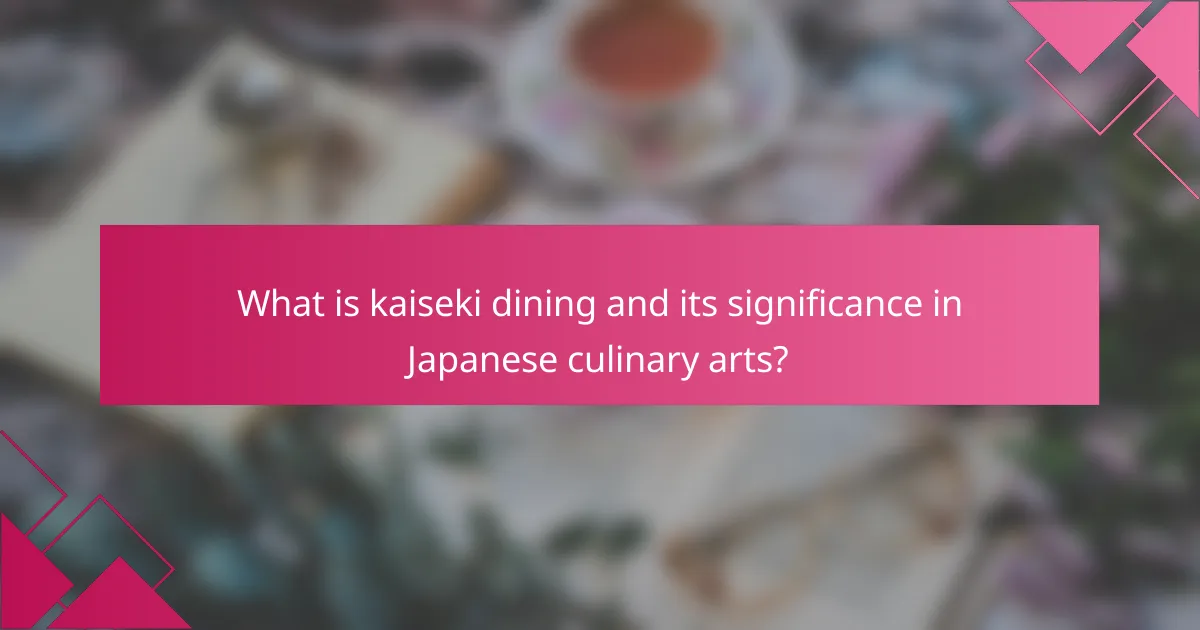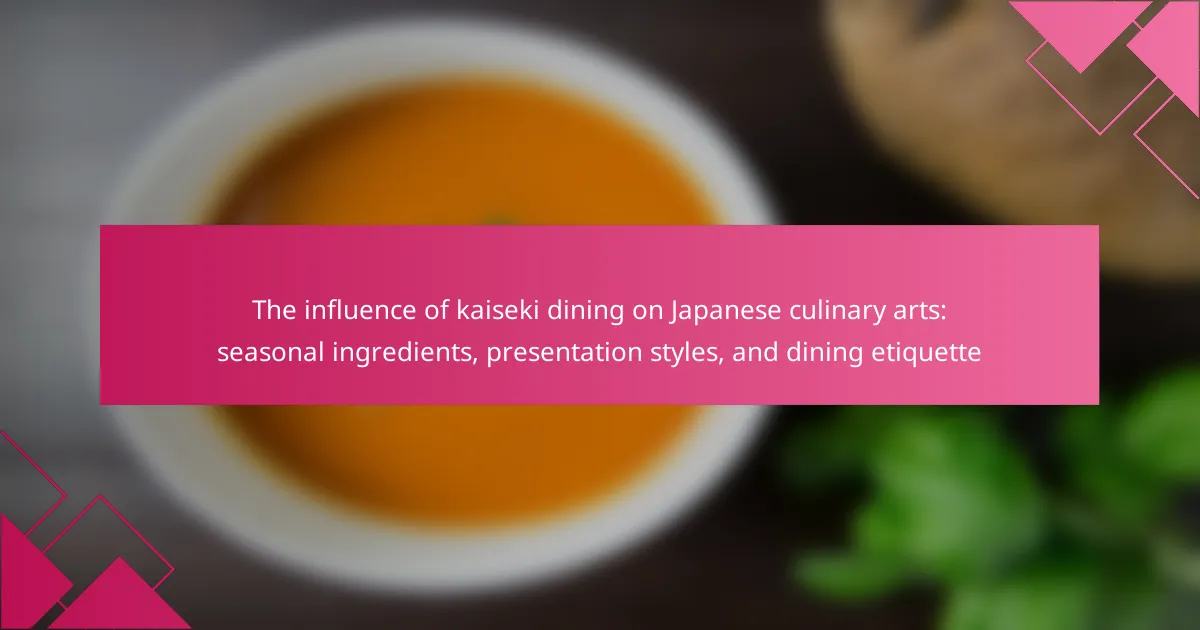
What is kaiseki dining and its significance in Japanese culinary arts?
Kaiseki dining is a traditional multi-course Japanese meal. It emphasizes seasonal ingredients and meticulous presentation. Kaiseki originated from the Japanese tea ceremony and evolved into a culinary art form. Each dish is crafted to highlight flavors and aesthetics. The significance lies in its reflection of Japanese culture and philosophy. It showcases harmony with nature and the changing seasons. Kaiseki also emphasizes the importance of balance in taste, texture, and color. This dining style has influenced modern Japanese cuisine and culinary practices globally.
How did kaiseki dining evolve over time?
Kaiseki dining evolved from Japanese tea ceremonies in the 16th century. Initially, it was a simple meal served during tea gatherings. Over time, it incorporated seasonal ingredients and refined presentation styles. By the 18th century, kaiseki became a formal multi-course dining experience. It emphasized balance, harmony, and aesthetics in food presentation. The evolution reflected changes in Japanese culture and culinary techniques. Today, kaiseki is recognized as an art form, showcasing the chef’s skill and seasonal flavors. Its influence extends to modern Japanese cuisine, emphasizing quality and presentation.
What historical influences shaped the development of kaiseki?
Kaiseki developed through various historical influences, primarily from Zen Buddhism and the tea ceremony. Zen Buddhism emphasized simplicity, mindfulness, and seasonal ingredients. This philosophy influenced the aesthetic and culinary practices of kaiseki. The tea ceremony, particularly during the 15th and 16th centuries, introduced a structured meal format that emphasized harmony and balance. Kaiseki meals were originally served as part of the tea ceremony to enhance the dining experience. The influence of aristocratic dining traditions also played a role, as kaiseki evolved from the elaborate banquets of the Japanese elite. Over time, kaiseki embraced local ingredients and seasonal variations, reflecting the changing Japanese landscape. The combination of these influences shaped kaiseki into a refined culinary art form.
How has kaiseki maintained its relevance in modern cuisine?
Kaiseki has maintained its relevance in modern cuisine by emphasizing seasonal ingredients and exquisite presentation. This traditional Japanese dining style adapts to contemporary tastes while preserving its core principles. The focus on fresh, local produce resonates with the modern farm-to-table movement. Additionally, kaiseki’s meticulous attention to detail in presentation aligns with current culinary trends that prioritize aesthetics. The incorporation of innovative techniques and flavors keeps kaiseki appealing to new generations. Furthermore, kaiseki dining experiences often emphasize mindfulness and appreciation of food, which aligns with modern wellness trends. This blend of tradition and innovation ensures kaiseki remains a significant influence in today’s culinary landscape.
What are the core principles of kaiseki dining?
Kaiseki dining is a traditional Japanese multi-course meal that emphasizes seasonal ingredients and meticulous presentation. The core principles include harmony, balance, and seasonality. Harmony refers to the overall aesthetic and taste balance in each dish. Balance is achieved through a variety of textures, colors, and flavors. Seasonality highlights the use of fresh, local ingredients that reflect the time of year. Kaiseki also focuses on presentation, with dishes arranged artfully to enhance visual appeal. The dining experience is designed to engage all senses. These principles stem from the tea ceremony, where simplicity and mindfulness are valued.
How does kaiseki emphasize seasonal ingredients?
Kaiseki emphasizes seasonal ingredients by focusing on the freshest produce available at the time. This dining style reflects the natural cycles of the seasons. Each dish is crafted to highlight specific ingredients that are at their peak. For example, spring might feature cherry blossoms, while autumn may showcase mushrooms. The menu changes throughout the year, ensuring variety and freshness. This practice not only enhances flavor but also connects diners to the environment. Kaiseki chefs often source ingredients locally to maintain seasonal authenticity. This approach is deeply rooted in Japanese culture, promoting appreciation for nature’s bounty.
What role does presentation play in the kaiseki experience?
Presentation is crucial in the kaiseki experience. It enhances the visual appeal of each dish. This visual artistry reflects the seasonality and freshness of the ingredients. Each plate is arranged with meticulous attention to detail. The use of color, shape, and texture creates a harmonious balance. This aesthetic presentation engages all senses, elevating the dining experience. Historical practices emphasize that presentation is as important as taste. Studies show that diners often perceive food as more flavorful when beautifully presented.
What are the essential elements of kaiseki dining etiquette?
The essential elements of kaiseki dining etiquette include proper seating arrangement, mindful eating, and appreciation of presentation. Guests should wait for the host to begin the meal before starting. It is customary to express gratitude before and after the meal, using phrases like “itadakimasu” and “gochisousama deshita.” Each course should be savored, and conversation should be kept light and respectful. Using chopsticks correctly is important; they should not be stuck upright in rice. Additionally, guests should avoid mixing dishes unless specified. Following these guidelines enhances the kaiseki experience and honors its cultural significance.
How should one behave during a kaiseki meal?
One should behave with respect and mindfulness during a kaiseki meal. This dining experience emphasizes appreciation for seasonal ingredients and presentation. Guests should wait for the host to begin the meal before starting to eat. It is polite to express gratitude before and after the meal. One should avoid speaking loudly or making disruptive noises while eating. Using chopsticks correctly is essential; do not stick them upright in rice. Guests should savor each dish, taking time to appreciate flavors and aesthetics. Engaging in conversation is encouraged, but it should be done in a respectful manner. This etiquette reflects the cultural significance of kaiseki dining in Japan.
What are the traditional customs associated with kaiseki dining?
Traditional customs associated with kaiseki dining include a focus on seasonality and aesthetics. Kaiseki emphasizes the use of fresh, seasonal ingredients. Each dish is presented with attention to color and arrangement. The meal typically follows a specific sequence, starting with lighter dishes and progressing to richer flavors. Guests are often encouraged to appreciate the visual presentation before tasting. The dining experience is usually accompanied by specific etiquette, such as using chopsticks properly and expressing gratitude before and after the meal. These customs reflect the deep cultural significance of kaiseki in Japanese culinary arts.

How do seasonal ingredients influence kaiseki dining?
Seasonal ingredients significantly influence kaiseki dining by dictating the menu’s composition and flavor profile. Kaiseki emphasizes the use of fresh, locally sourced ingredients that reflect the current season. This practice enhances the dining experience by providing a connection to nature and the passage of time. For example, spring kaiseki may feature sakura (cherry blossoms) and young bamboo shoots, while autumn may highlight mushrooms and chestnuts. The seasonal focus not only affects taste but also presentation, as dishes are often arranged to evoke the season’s aesthetic. This approach aligns with the Japanese philosophy of appreciating transience, known as “mono no aware.” Thus, seasonal ingredients are central to the authenticity and artistry of kaiseki dining.
What types of seasonal ingredients are commonly used in kaiseki?
Kaiseki commonly uses seasonal ingredients such as fresh fish, vegetables, and herbs. Each season brings unique produce that enhances the meal’s flavor and presentation. For example, spring features bamboo shoots and cherry blossoms. Summer highlights ingredients like sweet corn and tomatoes. Autumn showcases mushrooms and chestnuts. Winter includes root vegetables and fatty fish. These seasonal choices reflect the Japanese philosophy of harmony with nature. They also emphasize freshness and quality, critical in kaiseki cuisine.
How do these ingredients reflect the changing seasons?
Seasonal ingredients in kaiseki dining reflect the changing seasons through their availability and characteristics. Each ingredient is selected based on its peak season, ensuring freshness and flavor. For example, spring features ingredients like bamboo shoots and cherry blossoms, while summer highlights items such as cucumbers and tomatoes. Autumn brings mushrooms and chestnuts, and winter showcases root vegetables and fish. This seasonal selection not only enhances taste but also symbolizes nature’s cycles. The practice aligns with the Japanese philosophy of appreciating seasonal beauty and harmony, reinforcing cultural values in dining.
Why is the sourcing of local ingredients important in kaiseki?
The sourcing of local ingredients is crucial in kaiseki because it emphasizes freshness and seasonality. Kaiseki cuisine is designed to reflect the natural environment and the changing seasons. Using local ingredients ensures that the flavors are at their peak. It also supports local farmers and promotes sustainability. This practice is rooted in the Japanese philosophy of “shun,” which values ingredients at their optimal harvest time. Furthermore, local sourcing enhances the dining experience by providing a sense of place. Each dish tells a story of the region’s culture and culinary heritage. This connection to the land is a defining characteristic of kaiseki dining.
How do seasonal ingredients enhance the flavor profile of kaiseki dishes?
Seasonal ingredients enhance the flavor profile of kaiseki dishes by providing freshness and variety. These ingredients reflect the changing seasons, offering unique tastes and textures. For example, spring brings tender vegetables and delicate fish, while autumn features rich mushrooms and hearty roots. The use of seasonal produce aligns with the concept of “shun,” emphasizing peak flavor and quality. Seasonal ingredients also contribute to visual appeal, creating vibrant and colorful presentations. This practice fosters a deeper connection to nature and cultural traditions. Overall, seasonal ingredients are essential for achieving balance and harmony in kaiseki cuisine.
What techniques are used to highlight seasonal flavors?
Techniques used to highlight seasonal flavors include ingredient selection, presentation, and cooking methods. Kaiseki dining emphasizes using fresh, local produce that reflects the season. Seasonal ingredients are often showcased in their natural form to enhance their flavors. Cooking methods such as steaming, grilling, and simmering preserve the integrity of seasonal ingredients. Presentation techniques like color contrast and arrangement enhance visual appeal and emphasize seasonal themes. Seasonal flavors are also highlighted through the use of garnishes and accompaniments that complement the main ingredients. This practice not only elevates taste but also honors the seasonal aspects of the ingredients.
How do seasonal ingredients contribute to the overall dining experience?
Seasonal ingredients enhance the overall dining experience by providing freshness and flavor. They reflect the changing seasons and local agricultural practices. This connection to nature elevates the meal’s authenticity. Seasonal ingredients often have superior taste and nutritional value. For example, spring vegetables are known for their crispness and vibrant flavors. Utilizing these ingredients can create a more memorable meal. Additionally, they foster a sense of sustainability and support local farmers. This practice aligns with the principles of kaiseki dining, which emphasizes harmony with nature.

What are the unique presentation styles in kaiseki dining?
Kaiseki dining features unique presentation styles that emphasize aesthetics and seasonal themes. Each dish is artfully arranged to reflect the natural beauty of ingredients. The use of varied dishware enhances visual appeal and highlights the food’s colors and textures. Seasonal motifs are often incorporated into the presentation, aligning with the time of year. The arrangement typically follows a specific order, creating a harmonious flow throughout the meal. Attention to detail is paramount, with garnishes and sauces carefully placed to enhance the overall experience. This meticulous presentation style is rooted in traditional Japanese aesthetics, such as wabi-sabi, which appreciates imperfection and transience. These elements together create a multisensory dining experience that is both visually stunning and culturally significant.
How does presentation affect the perception of kaiseki dishes?
Presentation significantly affects the perception of kaiseki dishes. The visual arrangement influences diners’ expectations and enjoyment. A well-presented dish enhances the appreciation of flavors and textures. It can evoke emotions and set the dining atmosphere. Studies show that aesthetic appeal increases perceived taste quality. For instance, dishes arranged with seasonal elements reflect the essence of kaiseki. This aligns with the tradition of showcasing nature’s beauty. Thus, presentation is crucial in elevating the overall dining experience.
What artistic elements are incorporated into kaiseki presentation?
Kaiseki presentation incorporates various artistic elements, focusing on aesthetics and harmony. Key elements include the use of seasonal ingredients, which reflect nature’s beauty. The arrangement of dishes emphasizes balance and color contrast. Each dish is served on carefully selected tableware, enhancing visual appeal. The presentation often follows a theme, aligning with traditional Japanese aesthetics. Techniques like layering and height variation create depth. Attention to detail is paramount, showcasing the chef’s skill. Overall, kaiseki presentation embodies the principles of simplicity and elegance, reinforcing the dining experience’s artistry.
How does the arrangement of food reflect Japanese aesthetic principles?
The arrangement of food in Japanese cuisine reflects aesthetic principles such as simplicity, balance, and seasonal harmony. This is evident in kaiseki dining, where each dish is thoughtfully presented. The use of natural materials and colors enhances visual appeal. Seasonal ingredients are prioritized, showcasing the beauty of nature. Plates are arranged to create harmony and flow, emphasizing each item’s unique attributes. This approach aligns with the Japanese concept of wabi-sabi, which values imperfection and transience. Overall, food arrangement in Japan is a deliberate expression of cultural values and artistic sensibility.
What are the different serving styles in kaiseki dining?
Kaiseki dining features several distinct serving styles. These styles include “zukuri,” which emphasizes fresh sashimi presented on a plate. Another style is “nimono,” where ingredients are simmered and served in a broth. “Yakimono” refers to grilled dishes presented on a plate, showcasing seasonal ingredients. Additionally, “agemono” includes deep-fried items served in a visually appealing manner. Each style highlights the ingredients’ natural flavors and seasonal availability. Kaiseki dining is known for its meticulous presentation and balance of tastes. This attention to detail reflects the artistry of Japanese culinary traditions.
How does the progression of courses influence the dining experience?
The progression of courses significantly enhances the dining experience by creating a structured flow of flavors and textures. Each course in a kaiseki meal is thoughtfully designed to complement the previous one. This careful arrangement allows diners to appreciate seasonal ingredients fully. As flavors build from light to rich, the palate is prepared for each subsequent dish. The visual presentation of each course also contributes to the overall experience. It engages the senses beyond taste, making the meal a holistic event. Additionally, the pacing of courses encourages conversation and appreciation of the culinary art. Research indicates that multi-course dining can elevate satisfaction and enjoyment levels among diners.
What role do seasonal table settings play in kaiseki presentation?
Seasonal table settings play a crucial role in kaiseki presentation. They enhance the dining experience by reflecting the time of year and the ingredients used. Each season brings unique colors, textures, and themes to the table. For example, spring settings may include cherry blossoms, while autumn may feature maple leaves. This seasonal alignment creates a harmonious connection between the food and its environment. It also demonstrates the chef’s attention to detail and respect for nature. Seasonal elements are often incorporated into dishware and garnishes. This thoughtful presentation elevates the overall aesthetic of the meal.

How does dining etiquette shape the kaiseki experience?
Dining etiquette significantly shapes the kaiseki experience by enhancing the appreciation of the meal. Kaiseki is a traditional multi-course Japanese dining style. Proper etiquette emphasizes respect for the food and the chef. Guests are expected to savor each dish mindfully. This mindfulness elevates the sensory experience of flavors and textures. Additionally, etiquette dictates the order of consumption and the use of utensils. Following these customs reflects cultural values of harmony and respect. This structured approach contributes to the overall enjoyment and meaning of the kaiseki meal.
What are the key etiquette rules to follow during a kaiseki meal?
During a kaiseki meal, key etiquette rules include proper seating arrangement, using chopsticks correctly, and appreciating the presentation. Guests should wait for the host to begin the meal. It is polite to express gratitude before and after eating. Avoid mixing dishes unless instructed. Do not stick chopsticks upright in rice, as it resembles a funeral rite. Eating should be done at a moderate pace to savor flavors. Lastly, avoid speaking with a full mouth to maintain decorum. Following these rules enhances the dining experience and shows respect for the culinary art.
How does etiquette enhance the appreciation of kaiseki dining?
Etiquette enhances the appreciation of kaiseki dining by creating a respectful atmosphere. This dining style emphasizes harmony and mindfulness. Proper etiquette ensures that each course is savored and appreciated. It encourages diners to engage fully with the seasonal ingredients presented. Observing etiquette also reflects the cultural significance of the meal. For instance, the order of courses is carefully designed to enhance flavors. Additionally, the use of specific utensils and presentation methods adds to the overall experience. Overall, etiquette elevates kaiseki from a meal to an art form, enriching the dining experience.
What common mistakes should one avoid during a kaiseki experience?
Common mistakes to avoid during a kaiseki experience include inappropriate attire, poor timing, and disrespecting the meal’s structure. Wearing casual or overly formal clothing can disrupt the dining atmosphere. Arriving late may cause you to miss the carefully timed courses, which are designed to highlight seasonal ingredients. Ignoring the order of dishes can lead to a misunderstanding of the culinary narrative. Speaking loudly or using phones is considered disrespectful in this intimate setting. Lastly, failing to appreciate each dish’s presentation can diminish the overall experience, as kaiseki emphasizes aesthetics.
What tips can enhance one’s kaiseki dining experience?
To enhance one’s kaiseki dining experience, focus on understanding the seasonal ingredients used. Kaiseki emphasizes fresh, seasonal produce, which elevates flavors. Pay attention to the presentation styles, as aesthetics are crucial in kaiseki. Each dish is meticulously arranged to please the eye. Engage with the dining etiquette, such as using chopsticks properly and savoring each course. This reflects respect for the chef’s effort. Arrive with an open mind to appreciate the cultural significance of kaiseki. Consider pairing your meal with appropriate sake to complement the flavors. Lastly, take your time to enjoy the multi-course experience, as kaiseki is about savoring each moment.
How can one prepare for a kaiseki meal to maximize enjoyment?
To prepare for a kaiseki meal and maximize enjoyment, one should first familiarize themselves with the dining etiquette. Understanding the importance of seasonal ingredients enhances appreciation. Researching the specific dishes served in kaiseki can provide context. Arriving with an open mind allows for a better experience. Engaging with the chef or server can enrich the meal. Being aware of the presentation styles helps in appreciating the artistry. Lastly, savoring each course slowly enhances the overall experience.
What should diners know about the cultural significance of kaiseki?
Kaiseki is a traditional multi-course Japanese meal that embodies cultural significance. It reflects the principles of balance, seasonality, and artistry in Japanese cuisine. Kaiseki dining emphasizes the use of fresh, seasonal ingredients, showcasing the natural flavors of each component. The presentation of kaiseki dishes is meticulously crafted, highlighting aesthetics and harmony. This dining style originated from the Japanese tea ceremony and has evolved into a sophisticated culinary art form. Kaiseki meals often symbolize respect for nature and the changing seasons. Each dish is thoughtfully prepared to create a sensory experience that engages taste, sight, and smell. Understanding kaiseki enhances appreciation for Japanese culinary traditions and cultural values.
Kaiseki dining is a traditional multi-course Japanese meal that emphasizes seasonal ingredients, meticulous presentation, and dining etiquette. This article explores the evolution of kaiseki from its origins in the Japanese tea ceremony to its current status as a refined culinary art form. Key aspects include the historical influences that shaped kaiseki, the core principles guiding its practice, and the significance of seasonal ingredients in enhancing flavor and aesthetics. Additionally, the article examines the unique presentation styles and essential etiquette that contribute to the overall kaiseki dining experience, reflecting cultural values and culinary traditions in Japan.
